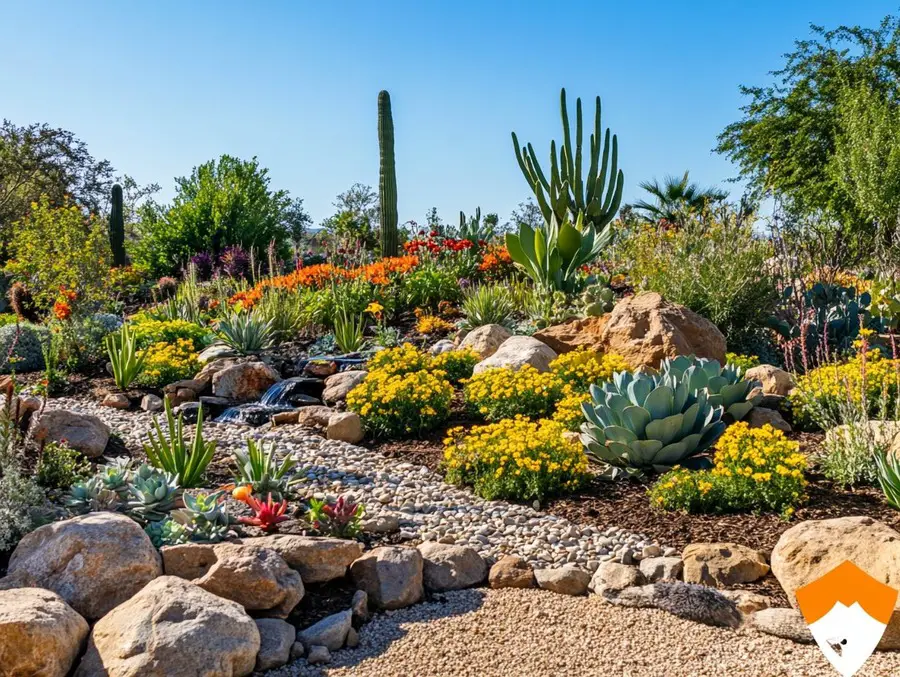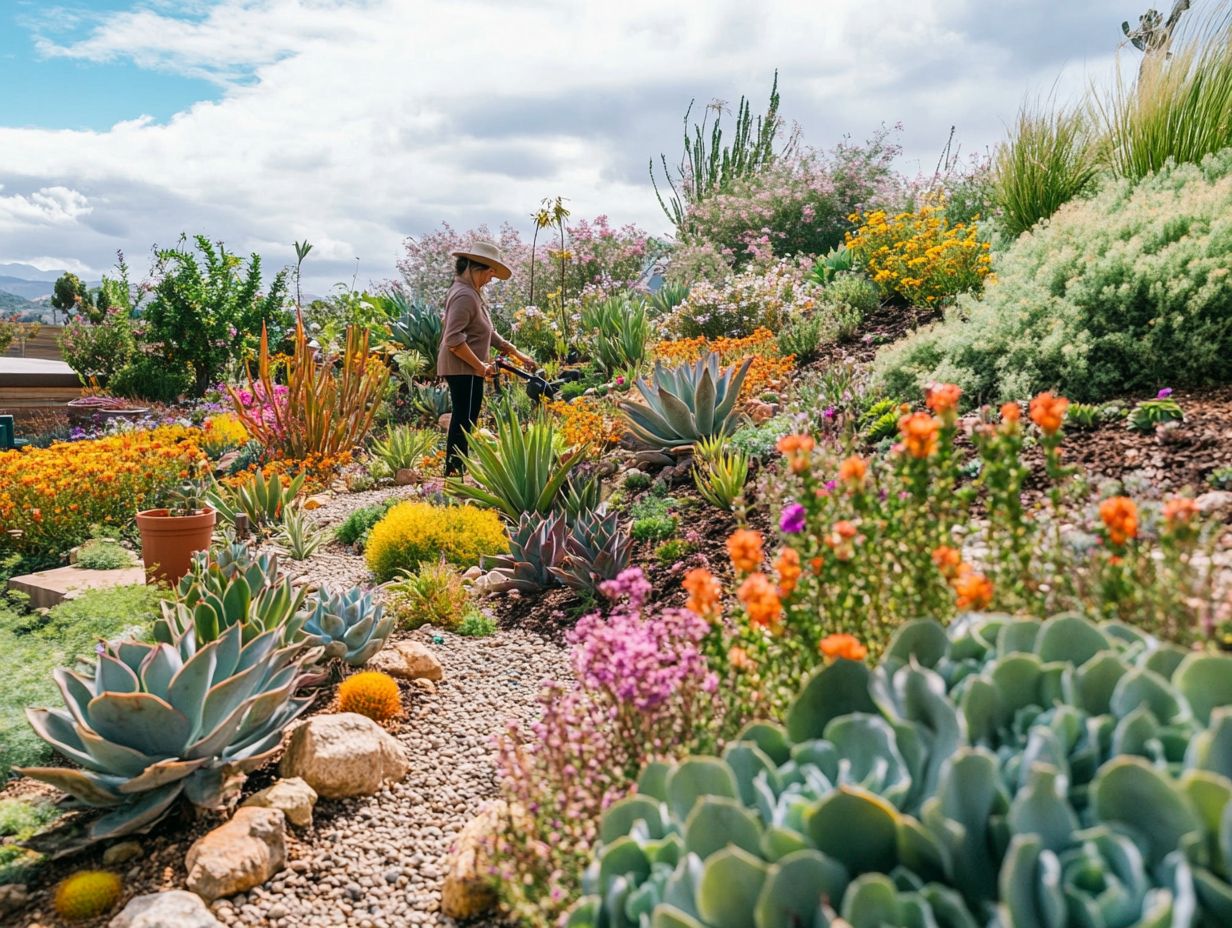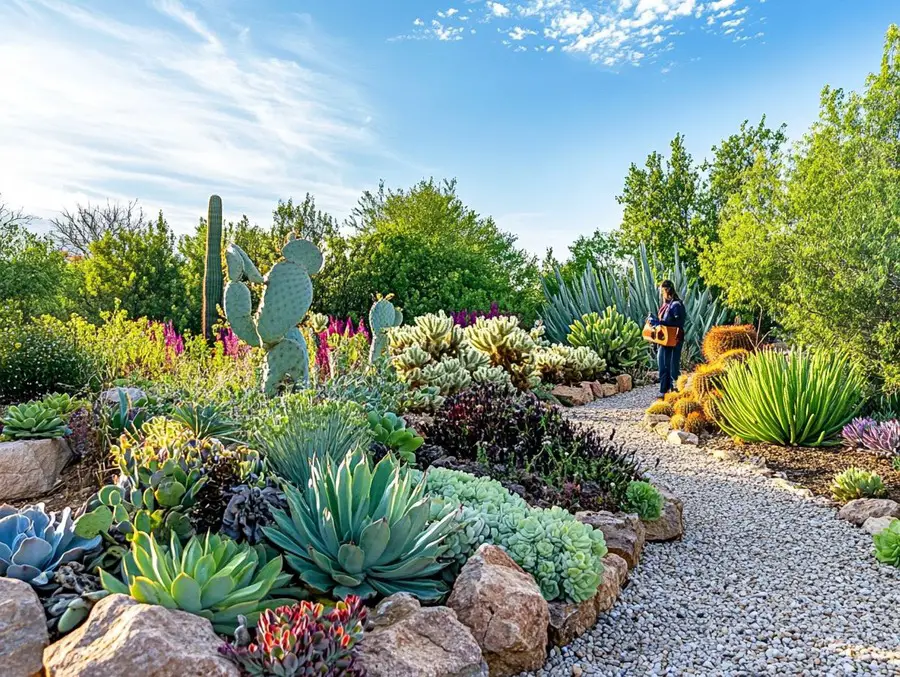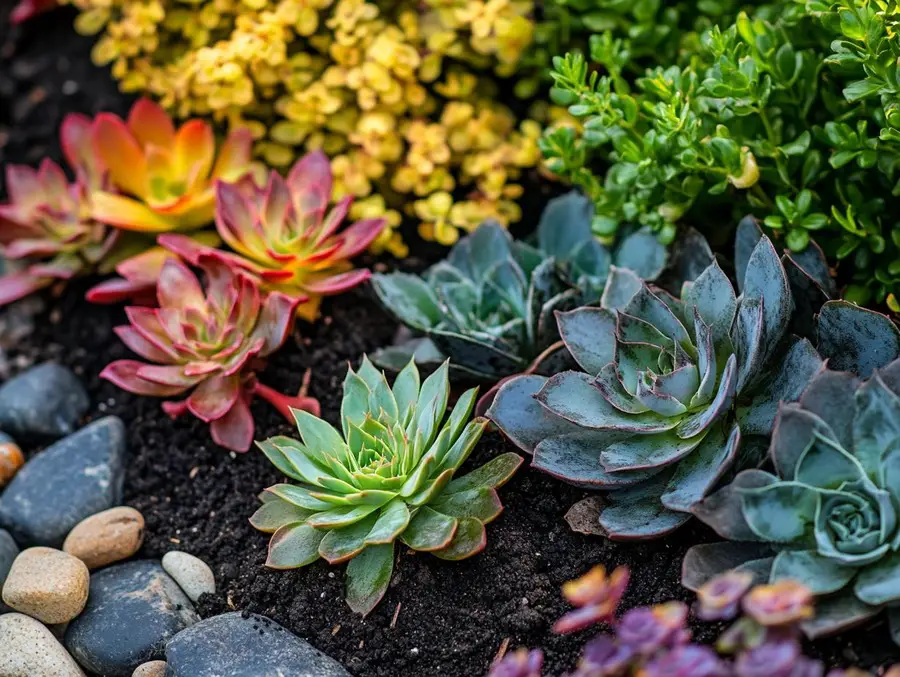We use affiliate links. If you purchase something using one of these links, we may receive compensation or commission.

Irrigation Basics for Xeriscaping is the key to keeping your drought-tolerant garden thriving while using as little water as possible.
Struggling with dry soil and plants that just won’t last?
By choosing the right irrigation method like drip systems or soaker hoses you can maximize efficiency, minimize waste, and keep your xeriscape lush and beautiful year-round.
Irrigation Basics for Xeriscaping
Key Takeaways
- Irrigation Basics for Xeriscaping focuses on water-efficient techniques like drip irrigation, soaker hoses, and strategic watering schedules.
- These methods deliver moisture directly to plant roots, reducing waste and promoting deep root growth.
- Choosing the right irrigation system creates a lush, sustainable landscape while conserving water and minimizing maintenance.
Irrigation Basics for Xeriscaping: Proven Success Secrets
Xeriscaping is a landscaping approach that focuses on water conservation, making it a fantastic choice for arid regions or anyone who wants to reduce their environmental footprint.
This article dives into the fundamentals of xeriscaping, highlighting its benefits and the crucial role irrigation plays in maximizing water efficiency.
You’ll get to learn about various irrigation systems like drip and sprinkler setups, and some handy tips for maintaining your landscape while keeping water waste to a minimum.
Join in as you navigate the essentials of smart irrigation for thriving xeriscaped gardens!
What is Xeriscaping?
Xeriscaping is a landscape design approach that puts water efficiency and sustainability front and center, which is especially important if you’re in an area where water can be scarce or drought conditions are common.
By using drought-resistant plants and native flora, you save water and boost the visual charm of your garden.
This gardening technique is all about choosing native plants that thrive in your local climate, which means you’ll need less watering and maintenance.
The principles of xeriscaping focus on smart plant selection and thoughtful garden layout to keep moisture in and minimize runoff.
This way, you can create a healthy ecosystem while also keeping your landscape looking great.
Definition and Benefits
Xeriscaping is all about creating a landscape that cuts down on the need for extra watering, focusing on water conservation and sustainable gardening practices.
By embracing this method, you can save a chunk of change on your water bills while also reducing the amount of time you spend on maintenance.
When you choose drought-resistant plants and use smart design techniques, you end up with a vibrant landscape that doesn’t require constant attention.
Xeriscaping isn’t just about saving water; it also boosts biodiversity by providing homes for various species.
And let’s not forget about the environmental benefits.
This approach supports ecological sustainability by minimizing your reliance on chemical fertilizers and pesticides.
It’s a fantastic way to create a beautiful outdoor space while being mindful of water resources and doing your part for the planet.
The Importance of Irrigation in Xeriscaping
 Irrigation is super important in xeriscaping because it ensures that your drought-resistant plants get the moisture they need to thrive, especially during those dry spells or when seasonal rains are lacking.
Irrigation is super important in xeriscaping because it ensures that your drought-resistant plants get the moisture they need to thrive, especially during those dry spells or when seasonal rains are lacking.
Using effective techniques like drip irrigation and smart watering systems can really boost your water conservation efforts, helping you manage your resources more efficiently.
By setting up a solid irrigation schedule and management practices, you can keep soil moisture levels just right for healthy plant growth while cutting down on water waste.
Getting to know your local climate and soil types is key for creating an irrigation plan that works perfectly with your xeriscape design.
How Irrigation Plays a Role in Water Conservation
Irrigation is a key player in your water conservation strategies when it comes to xeriscaping.
It helps you make the most of your water use while ensuring your plants get the right amount of moisture to thrive.
Different irrigation methods are essential for striking that balance.
Techniques like drip irrigation and soaker hoses deliver targeted moisture right to the root zone, which really boosts moisture retention in the soil.
This precision is a game changer because it cuts down on water waste that often happens with traditional overhead watering systems.
Understanding things like evapotranspiration—the process where water evaporates from the soil and plants can really help you optimize your approach.
If you schedule irrigation properly, you can align it with natural conditions, allowing the soil to hold onto moisture better.
This supports healthier plant growth and also encourages deeper root systems that are more resilient during droughts.
Types of Irrigation Systems

You’ll find a variety of irrigation systems out there, each tailored to meet different gardening needs and water conservation goals.
Think about drip irrigation, sprinkler systems, and soaker hoses.
Drip irrigation is a game changer because it delivers moisture right to the root zones of your plants, which helps minimize evaporation and runoff.
If you have a larger area to cover, sprinkler systems can provide broader coverage.
On the other hand, soaker hoses are great for gently keeping soil moisture without wasting water.
Choosing the right irrigation method is key to keeping your plants healthy and your landscape sustainable.
Overview of Drip, Sprinkler, and Soaker Hose Systems
Drip irrigation, sprinkler systems, and soaker hoses are three popular irrigation methods, each with its own perks for keeping soil moisture in check and helping your plants thrive in xeriscaped gardens.
When you’re deciding which method to go for, it’s important to take a good look at how each one works.
Drip irrigation, for example, delivers water straight to the roots of your plants, which means less evaporation and better water conservation.
On the flip side, sprinkler systems cover a larger area, making them great for bigger spaces, but they can also lead to more water loss due to evaporation and runoff.
Then there are soaker hoses, which are another fantastic choice.
They allow water to seep gently into the soil, helping to keep moisture levels up while also cutting down on surface evaporation.
In terms of installation, make sure you get the spacing and positioning just right.
And don’t forget about regular maintenance like checking for clogs in your drip lines or ensuring your sprinklers are distributing water evenly can really boost how effective each system is.
Designing an Irrigation Plan for Xeriscaping
When you’re designing an effective irrigation plan for xeriscaping, it’s important to think about a few key factors.
You’ll want to consider things like plant selection, soil types, and how well your choices adapt to the climate.
This way, you can ensure efficient watering and really make the most of water conservation.
Factors to Consider and Tips for Efficiency
When you’re designing an irrigation plan, think about factors like your local climate, the water needs of your plants, soil amendments, and how moisture sensors can step up your irrigation game.
By considering the unique climate conditions in your area, you can figure out the best timing and frequency for watering.
Understanding what different plants require in terms of water helps you create a more effective irrigation schedule.
Don’t underestimate the importance of soil amendments.
They improve soil structure and retention, helping water penetrate deeply and get absorbed efficiently.
Using moisture sensors can give you real-time data, allowing you to tweak your watering based on current soil moisture levels, which can really cut down on water waste.
And if you’re looking to take it up a notch, exploring advanced techniques like drip irrigation can boost efficiency by delivering water straight to the roots where it matters most.
Maintaining and Troubleshooting Irrigation Systems

Keeping your irrigation systems in tip-top shape is crucial for making sure your xeriscaping efforts are efficient and effective.
By doing regular maintenance and troubleshooting, you can avoid the common issues that lead to water waste and keep your plants healthy.
Common Issues and Solutions
Common issues with irrigation systems, like uneven watering or clogged emitters, can really mess with your irrigation efficiency and plant health if you don’t tackle them head-on.
These problems can lead to overwatering in one area, which just invites mold and root rot to the party, while other spots may not get enough water, leaving your plants stressed and looking a bit sad. Regular garden maintenance is key here.
Checking on your hoses, timers, and valves can help you spot these issues before they become major headaches.
Doing a little audit of your irrigation system means you can make timely adjustments and repairs, ensuring that every drop of water is used efficiently.
By jumping on typical challenges like leaky pipes, low water pressure, and system clogs right away, you can create the best environment for your plants while keeping those precious resources in check.
Frequently Asked Questions
What is xeriscaping and why is irrigation important for it?
Xeriscaping is a landscaping method that focuses on conserving water by using drought-resistant plants and efficient irrigation techniques.
Irrigation is vital for xeriscaping because it ensures that plants receive the necessary amount of water in a water-scarce environment.
What are the different types of irrigation systems used in xeriscaping?
The most common types of irrigation systems used in xeriscaping are drip irrigation, micro-sprinkler systems, and low-volume sprinkler systems.
These systems allow for precise and targeted watering, minimizing water waste.
How often should I water my xeriscaped plants?
The frequency of watering will depend on factors such as climate, soil type, and plant species.
Generally, xeriscaped plants should be watered deeply and infrequently, allowing the soil to dry out in between watering to promote deep root growth.
What are some best practices for efficient irrigation in xeriscaping?
Some best practices for efficient irrigation in xeriscaping include adjusting watering schedules based on seasonal weather changes, using mulch to retain moisture in the soil, and regularly checking for leaks or clogs in the irrigation system.
Can I use rainwater for irrigation in xeriscaping?
Yes, using rainwater for irrigation in xeriscaping is a great way to conserve water.
You can collect rainwater in a barrel or cistern and use it to water your plants during dry periods.
How can I ensure that my irrigation system is water-efficient?
To ensure water efficiency, make sure to regularly maintain and inspect your irrigation system.
This includes fixing any leaks or broken sprinkler heads, adjusting water pressure, and upgrading to more efficient technologies if needed.
Best Plants for Xeriscape Gardens: Hardy & Beautiful
Xeriscape Garden Styles: Easy Low-Maintenance Options
Xeriscape Gardening Techniques: Easy Low-Water Tips
Xeriscape Garden Design & Layout: Easy Water-Wise Beauty
What is xeriscaping? A beginner’s guide to drought-tolerant landscaping – Colorado State University
Related Content
Visit my Amazon Influencer Page for videos and gardening products Grow Your Own Garden




